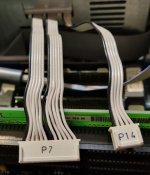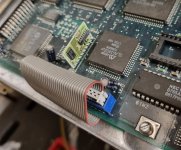This is a model 8530-H31 - which is, as far as I can tell, equivalent to the 8530-E31. Or, I should say, was.
Thus the destruction happened: I had errors 161 and 163, which indicated a flat battery in the Dallas RTC. So I removed the chip, and proceeded to mod it with an attached coincell battery. Then I replaced the modded Dallas, but in the process I inserted it in the wrong orientation. There was no image, no memory count, the drive would not spin up, and there was no beep prompting to press F1 on the keyboard. Finally I realized the issue with the Dallas chip's orientation. When I removed it, I noticed it was burning hot. I tried to put it in the correct orientation, but to no avail, the machine is dead. The HD seems to try to spin up but soon enough slows down again, without any seek sound.
Right now I am extremely upset. I was hoping that writing this would make me feel a bit better, but it's just marginal.
Extra upsetting because this machine cost me quite a lot of money.
I wonder if there is anything salvageable. Maybe the CPU, the memory modules, the HD and the floppy drive? But everything else is a write-off. I have no chance to repair the motherboard, even if I knew which of these SMD chipset ICs have been fried. And the case is completely useless without the motherboard. No other motherboard would fit inside. And no motherboard is compatible with this PSU.
Thus the destruction happened: I had errors 161 and 163, which indicated a flat battery in the Dallas RTC. So I removed the chip, and proceeded to mod it with an attached coincell battery. Then I replaced the modded Dallas, but in the process I inserted it in the wrong orientation. There was no image, no memory count, the drive would not spin up, and there was no beep prompting to press F1 on the keyboard. Finally I realized the issue with the Dallas chip's orientation. When I removed it, I noticed it was burning hot. I tried to put it in the correct orientation, but to no avail, the machine is dead. The HD seems to try to spin up but soon enough slows down again, without any seek sound.
Right now I am extremely upset. I was hoping that writing this would make me feel a bit better, but it's just marginal.
Extra upsetting because this machine cost me quite a lot of money.
I wonder if there is anything salvageable. Maybe the CPU, the memory modules, the HD and the floppy drive? But everything else is a write-off. I have no chance to repair the motherboard, even if I knew which of these SMD chipset ICs have been fried. And the case is completely useless without the motherboard. No other motherboard would fit inside. And no motherboard is compatible with this PSU.


